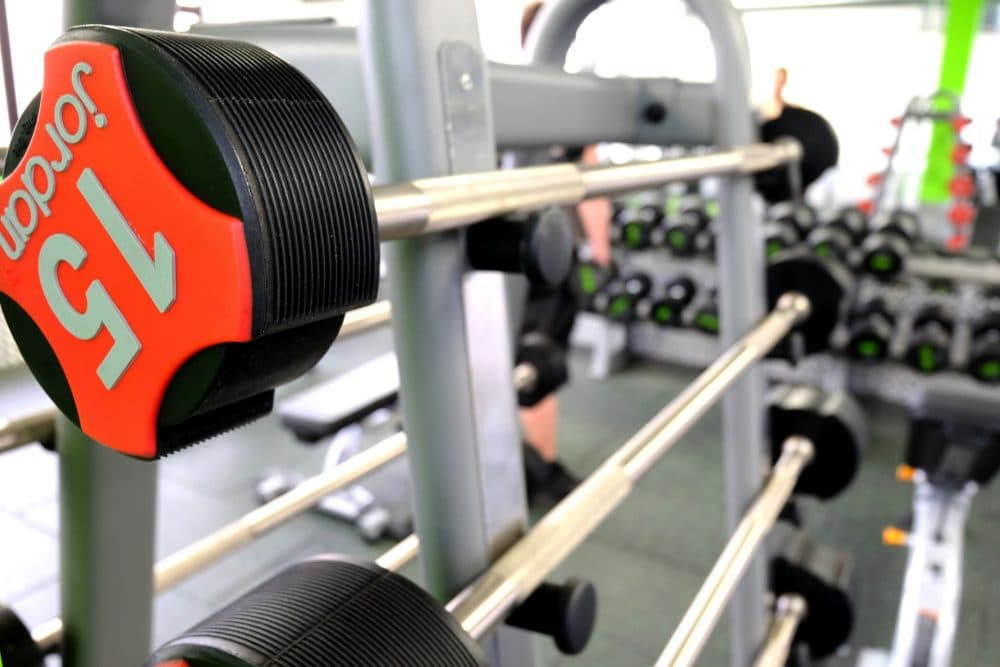Advertisement
Exercise In A Bottle? The Story Of The 'Exercise Pill'
Resume
This is a story about something about as sci-fi as a flying car, or maybe a machine that records your dreams in hi-def so you can view them later at your leisure. Or almost like that.
Our guide for this trip into the future is Nicola Twilley.
This thrill ride begins where Twilley's New Yorker story began, with a visit to the Salk Institute in San Diego. There she met a biologist named Ron Evans, who introduced Twilley to a couple of mice. Evans called one of them "Couch Potato Mouse," and the other one "Lance Armstrong Mouse."
"Couch Potato Mouse is, I mean, frankly, kind of fat — the rolls of fat visible beneath his fur, which is also thinning, kind of greasy looking," she says. "Couch Potato Mouse is lolling in the sort of crinkly nest material that they keep in their cages."
This disgrace to all of mouse-dom had been fed a blend of fat and sugar meant to mimic the average Western diet. He’s also been deprived of the opportunity to exercise. No wonder he’s lolling.
But here’s where it gets weird, in a futuristic sort of way. Lance Armstrong Mouse has been fed the same lousy diet, and he hasn’t exercised.
"By contrast, Lance Armstrong Mouse was lean and taut and shiny, and his whiskers were twitching, and he was moving around the cage, sort of snuffling and looking at things," Twilley says. "It was sort of shocking."
"Shocking," is Twilley's word for it. Mine was "weird."
GW501516: 'Exercise In A Pill'
Ron Evans put the two mice through their paces, and appearances were not deceiving. Lance Armstrong Mouse was almost twice as fast on the mouse track as Couch Potato Mouse. Lance Armstrong Mouse didn’t just look better — he was better, just like at the Tour de France, which is kind of the giveaway, isn’t it?
"Lance Armstrong Mouse had been given this daily dose of a drug called GW501516," Twilley says. "And that is what made the difference. That’s what gave it its astonishing physique."
That drug’s nickname is 516, though Evans calls it "exercise in a pill," which suggests that he’s a biologist with a sense of humor. But according to Twilley, there’s nothing funny — or particularly mysterious — about how and why 516 works.
"If you think about it scientifically, it makes perfect sense," she says. "When you move your muscles, the changes that occur — and we know that changes occur during training — they have to be chemical. That’s the only way things happen in your body. So, if we could only figure out the chemistry of those changes that happen when you train daily, or when you lift weights, or whatever, then we could give you a synthetic replacement, and you wouldn’t have to train daily or lift weights."
"He said for stamina, there’s nothing like it."
Nicola Twilley
And you wouldn’t look like the human equivalent of sloppy, lolling Couch Potato Mouse.
You’re intrigued, right? Twilley was. So after she’d met those two mice, she went online and ordered a little 516 -- all in the name of research.
"It was a liquid form -- a little bottle of sort of cloudy, white, watery liquid, in a little hotel shampoo-size bottle," she says.
Sounds innocent enough, I guess. As long as the little bottle came with instructions.
"The label, amazingly, said, 'See accompanying information for dosage,' " Twilley recalls. "Well, there was no accompanying information. And it said, 'Prescription only,' and then beneath that it said, 'Not for human consumption,' which were two contradictory and not reassuring statements."
Well, yeah, but the guy who sent the stuff probably figured, "Hey, mice can't read. And who'd feed cloudy, white stuff to anything but a mouse?"
Iron Julius
The stuff Twilley got in the mail, assuming it was the real thing, was first developed a couple of decades ago by a pharmaceutical company looking for something that would reduce cholesterol.
"And they tested it on obese monkeys," Twilley says. "They discovered that it raised their good cholesterol, lowered their bad cholesterol, lowered their triglycerides — which are bad — lowered their insulin levels. And so they thought they were on to a winner."
A reasonable assumption, especially given that the aforementioned Western diet has created millions of candidates for a drug that does those things. In clinical trials, 516 did all that it was supposed to do in the test rats, but it didn’t stop there.
"They get the results in from toxicology tests on rats. And they had developed tumors all over their body," Twilley says. "They had a hugely increased rate of cancer."
That’s not the sort of thing you can gloss over with a rapid-fire warning at the end of a TV commercial, so 516 did not become available to the general public. But labs kept producing it for experimental purposes, and, the internet being what it is, Twilley had no trouble tapping into the market. But she thought that before dosing herself, she’d ask around to see what folks who were using 516 had to say.
On the internet, she’d found a fellow who claimed he’d been using the drug for six years. He called himself "Iron Julius."
"He wouldn’t tell me his real name. He’s a volunteer firefighter, lives in a small town in the South, father of three," Twilley says. "And he said for stamina, there’s nothing like it.
"His wife had tried to get him to do a 5K with her, and he hadn’t done any training. And he was thinking he would just have to walk. And he started taking 516, and he ran the whole thing. And he said it blew his mind how good he felt. So he’s a fan."
But what about the tumors that popped up all over those rats?
"He said, 'Look, everything gives you cancer. No big deal. I’m not worried,' " Twilley explains.
Sound like an endorsement to you? OK, then.
'We Should Just Exercise'
But Twilley wasn’t entirely convinced. So she called Tim Willson, the guy who’d originally designed 516.
"And I said, 'Look, I’ve got this. Shall I take some?' And he said, 'No,' " Twilley recalls. "So I said, 'Well, why not?' And he said, 'Look, you exercise. You don’t need this. You also know how to get more exercise, if you think that’s necessary. The risk-benefit ratio is not right for you. It might be right for someone with Duchenne Muscular Dystrophy. It might be right for someone who can’t walk, for whatever reason. It’s not a favorable risk-benefit ratio for you.' So I put the bottle down and chickened it, basically."
Or fell back on good sense. I guess it’s all in your point of view.
As a researcher and writer rather than lab rat, Nicola also learned that Ron Evans — the guy monitoring Lance Armstrong Mouse — is still trying to develop a less toxic variant of 516. Phase I trials with humans have already begun. Other so-called exercise pills are also in the works. But Twilley doesn’t see herself as a potential candidate for human trials.
"The irony of reporting on an exercise pill was that the more I learned about what exercise actually does and the biochemistry of exercise, the more I thought, 'You know what? We should just exercise. Exercise is great. There is nothing that is that great for you,' " she says. "So, we should just be doing that instead."
I have to agree. But the flying car would still be cool, right? And the machine that would enable you to replay your dreams? Oh, yeah.
Read Nicola Twilley's New Yorker piece, "A Pill To Make Exercise Obsolete."
This segment aired on March 3, 2018.
